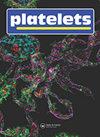Recent advances on GPIb-IX-V complex.
IF 2.5
3区 医学
Q3 CELL BIOLOGY
引用次数: 0
Abstract
An abundant receptor complex exclusively expressed on the surface of platelets and megakaryocytes, glycoprotein (GP)Ib-IX-V complex plays a major role in hemostasis and thrombosis. Its importance is corroborated by the bleeding symptoms in patients with congenital defects in this complex [1]. GPIbα, the main subunit in this receptor complex, contains the binding domain for plasma protein von Willebrand factor (VWF) and thrombin [2–4]. Recent studies, utilizing genetically altered animal models as well as new cutting-edge biomechanical, molecular, and cellular techniques, produced exciting insights on the inner workings of this receptor complex and expanded its involvement into platelet clearance, cancer metastasis, and inflammatory complications. Some studies have also identified potential new ligands of GPIbα, such as the SARS-CoV-2 spike protein [5], although the underlying mechanisms await verification and further elucidation [6]. Thus, it is appropriate time to review recent advances on GPIb-IX -V and related pathways. Dr Jerry Ware led the development of the first genetically altered murine model for GPIbα, which validates the applicability of mice to study GPIb-IX-V and to model related diseases [7]. In his review, Dr Ware describes various knockout and transgenic murine models that alter either receptor expression or an aspect of GPIb-IX functions. Their characterization has firmly established critical involvement of GPIb-IX in platelet generation, activation, and clearance and also generated valuable insights on the underlying mechanisms. Critical features associated with each murine model, along with important caveats, are noted and compared, which would be important in data interpretation as these animal models are increasingly applied to assess the involvement of GPIb-IX in a variety of physiological or pathophysiological processes. Dr Edward Quach is a young investigator who reported key evidence for the defining mechanical feature of GPIb-IX activation [8]. His review focuses on recent exciting advances in understanding how GPIb-IX activation critically drives platelet clearance in several common thrombocytopenic conditions. A common feature in the form of a conformational change in GPIb-IX appears in these disease settings, which may be potentially applicable to other more complications involving thrombocytopenia. Dr Xiaoping Du first demonstrated the association of GPIX with GPIbα and GPIbβ to form a highly integrated GPIb-IX complex [9]. Here, he and his coworkers review the intracellular signaling events that are induced by GPIb-IX ligands and lead up to the activation of integrin αIIbβ3 in platelets. Intracellular molecules associated with cytoplasmic domains of GPIb-IX, such as 14-3-3ζ and filamin, are required for these signaling pathways. Additional downstream kinases and related molecules, connecting extensively with other signaling pathways, are also delineated. Finally, although GPV is associated with GPIb-IX and highly expressed, its structure and main biological function remain a mystery. Having first cloned human GPV [10], Dr Francois Lanza and his colleagues review unique features of GPV, including it being a substrate of thrombin and other proteases. They also describe intriguing observations associated with soluble GPV in disease settings, along with recent studies exploring GPV as a biomarker and/or modulator in these processes. Recent advances on the GPIb-IX-V complex have laid the foundation for future investigations on a number of outstanding questions about this intriguing receptor complex, some of which are described in the reviews of this series. As the interaction of GPIbα with VWF is essential for primary hemostasis, directly blocking this interaction, especially under high shear conditions, will cause bleeding as well as thrombocytopenia. Recent advances on GPIb-IX-V have made it possible to test new approaches of targeting other parts of the complex than the VWF-binding domain of GPIbα [11] and explore related translational opportunities.GPIb-IX-V复合物的研究进展。
本文章由计算机程序翻译,如有差异,请以英文原文为准。
求助全文
约1分钟内获得全文
求助全文
来源期刊

Platelets
医学-细胞生物学
CiteScore
6.70
自引率
3.00%
发文量
79
审稿时长
1 months
期刊介绍:
Platelets is an international, peer-reviewed journal covering all aspects of platelet- and megakaryocyte-related research.
Platelets provides the opportunity for contributors and readers across scientific disciplines to engage with new information about blood platelets. The journal’s Methods section aims to improve standardization between laboratories and to help researchers replicate difficult methods.
Research areas include:
Platelet function
Biochemistry
Signal transduction
Pharmacology and therapeutics
Interaction with other cells in the blood vessel wall
The contribution of platelets and platelet-derived products to health and disease
The journal publishes original articles, fast-track articles, review articles, systematic reviews, methods papers, short communications, case reports, opinion articles, commentaries, gene of the issue, and letters to the editor.
Platelets operates a single-blind peer review policy. Authors can choose to publish gold open access in this journal.
 求助内容:
求助内容: 应助结果提醒方式:
应助结果提醒方式:


